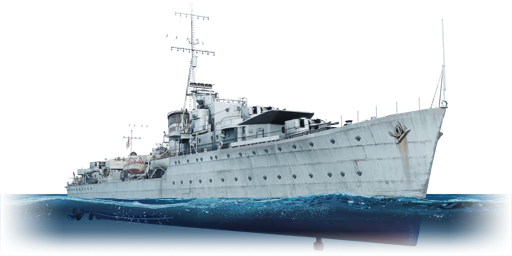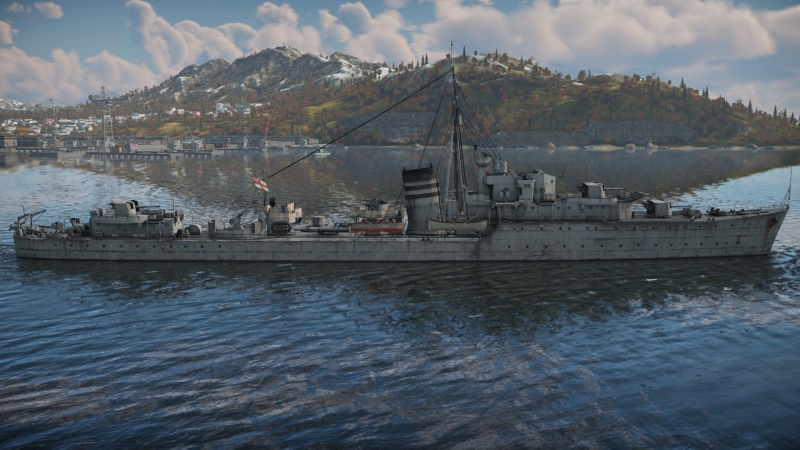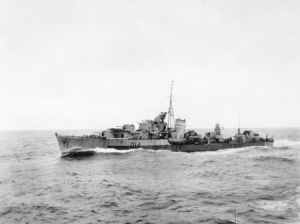Difference between revisions of "HMAS Nepal"
R_nminbiY_n (talk | contribs) m |
Colok76286 (talk | contribs) (Edits) |
||
| Line 53: | Line 53: | ||
The N-class is similar to the other rank II 4.3 destroyer, the [[Tribal (F75)|Tribal]], sharing an identical main armament and near-identical auxiliary batteries. While the N-class lacks the Tribal's powerful secondary battery and larger crew size, it makes up for it with a better top speed, more torpedoes, and a more effective AA battery. This makes the N-class something of a jack-of-all-trades, while also still giving it the powerful long-range firepower found on the Tribal. | The N-class is similar to the other rank II 4.3 destroyer, the [[Tribal (F75)|Tribal]], sharing an identical main armament and near-identical auxiliary batteries. While the N-class lacks the Tribal's powerful secondary battery and larger crew size, it makes up for it with a better top speed, more torpedoes, and a more effective AA battery. This makes the N-class something of a jack-of-all-trades, while also still giving it the powerful long-range firepower found on the Tribal. | ||
| − | The N-class' guns are the star of the show. While the 4.7-inch cannons lack the deadly rate | + | The N-class' guns are the star of the show. While the 4.7-inch cannons lack the deadly rate of fire of the American 5-inch guns, they still pack a hefty punch. They are also some of the most accurate destroyer guns in the game, only beaten in accuracy by the 100 mm guns of the Akizuki. Having four of the guns pointing forwards also allows the N-class to concentrate a constant, heavy barrage of fire directly forwards, allowing it to leave a smaller profile for enemy guns to hit. Make use of the N-class effectiveness at long-ranges and attack other destroyers from afar. |
When opponents do get closer, the N-class is still a nasty ship to fight. While the main turrets have a slow traverse, the guns at close ranges are scarily accurate and will hit hard when they do impact. In addition, the N-class has 5 torpedoes, which have an average speed but do immense damage on impact. One torpedo hit can be enough to sink some destroyers, and will do heavy damage to the light cruisers the N-class can fight in an uptier. Aircraft will also struggle immensely against the N-class, thanks to its powerful AA battery. The 20 mm guns can cause a spray of fire for fighter-bombers to avoid, while the quad-barreled 40 mm cannon will make short work of larger aircraft that stray too close. The N-class is also a very fast destroyer once fully upgraded, allowing it to get in and out of position with ease, as well as dictate the flow of the battle effectively. | When opponents do get closer, the N-class is still a nasty ship to fight. While the main turrets have a slow traverse, the guns at close ranges are scarily accurate and will hit hard when they do impact. In addition, the N-class has 5 torpedoes, which have an average speed but do immense damage on impact. One torpedo hit can be enough to sink some destroyers, and will do heavy damage to the light cruisers the N-class can fight in an uptier. Aircraft will also struggle immensely against the N-class, thanks to its powerful AA battery. The 20 mm guns can cause a spray of fire for fighter-bombers to avoid, while the quad-barreled 40 mm cannon will make short work of larger aircraft that stray too close. The N-class is also a very fast destroyer once fully upgraded, allowing it to get in and out of position with ease, as well as dictate the flow of the battle effectively. | ||
| Line 103: | Line 103: | ||
== Media == | == Media == | ||
| − | ''Excellent additions to the article would be video guides, screenshots from the game, and photos.'' | + | <!-- ''Excellent additions to the article would be video guides, screenshots from the game, and photos.'' --> |
| + | |||
| + | ;Skins | ||
| + | * [https://live.warthunder.com/feed/camouflages/?vehicle=uk_destroyer_n_class Skins and camouflages for the {{PAGENAME}} from live.warthunder.com.] | ||
== See also == | == See also == | ||
''Links to articles on the War Thunder Wiki that you think will be useful for the reader, for example:'' | ''Links to articles on the War Thunder Wiki that you think will be useful for the reader, for example:'' | ||
| − | |||
* ''reference to the series of the ship;'' | * ''reference to the series of the ship;'' | ||
* ''links to approximate analogues of other nations and research trees.'' | * ''links to approximate analogues of other nations and research trees.'' | ||
| Line 114: | Line 116: | ||
<!-- ''Paste links to sources and external resources, such as:'' | <!-- ''Paste links to sources and external resources, such as:'' | ||
* ''topic on the official game forum;'' | * ''topic on the official game forum;'' | ||
| − | |||
* ''other literature.'' --> | * ''other literature.'' --> | ||
Revision as of 20:43, 21 January 2022
Contents
Description
The N-class, HMAS Nepal (G25), 1942 is a rank II British destroyer with a battle rating of 4.3 (AB/RB/SB). It was introduced in Update 1.83 "Masters of the Sea" as part of the British fleet closed beta test.
General info
Survivability and armour
Talk about the vehicle's armour. Note the most well-defended and most vulnerable zones, e.g. the ammo magazine. Evaluate the composition of components and assemblies responsible for movement and manoeuvrability. Evaluate the survivability of the primary and secondary armaments separately. Don't forget to mention the size of the crew, which plays an important role in fleet mechanics. Save tips on preserving survivability for the "Usage in battles" section. If necessary, use a graphical template to show the most well-protected or most vulnerable points in the armour.
Mobility
Write about the ship's mobility. Evaluate its power and manoeuvrability, rudder rerouting speed, stopping speed at full tilt, with its maximum forward and reverse speed.
| Mobility Characteristics | |||
|---|---|---|---|
| Game Mode | Upgrade Status | Maximum Speed (km/h) | |
| Forward | Reverse | ||
| AB | |||
| Upgraded | 85 | 31 | |
| RB/SB | |||
| Upgraded | 69 | 25 | |
Modifications and economy
Armament
Primary armament
Provide information about the characteristics of the primary armament. Evaluate their efficacy in battle based on their reload speed, ballistics and the capacity of their shells. Add a link to the main article about the weapon: {{main|Weapon name (calibre)}}. Broadly describe the ammunition available for the primary armament, and provide recommendations on how to use it and which ammunition to choose.
Secondary armament
Some ships are fitted with weapons of various calibres. Secondary armaments are defined as weapons chosen with the control Select secondary weapon. Evaluate the secondary armaments and give advice on how to use them. Describe the ammunition available for the secondary armament. Provide recommendations on how to use them and which ammunition to choose. Remember that any anti-air armament, even heavy calibre weapons, belong in the next section. If there is no secondary armament, remove this section.
Anti-aircraft armament
An important part of the ship's armament responsible for air defence. Anti-aircraft armament is defined by the weapon chosen with the control Select anti-aircraft weapons. Talk about the ship's anti-air cannons and machine guns, the number of guns and their positions, their effective range, and about their overall effectiveness – including against surface targets. If there are no anti-aircraft armaments, remove this section.
Additional armament
Describe the available additional armaments of the ship: depth charges, mines, torpedoes. Talk about their positions, available ammunition and launch features such as dead zones of torpedoes. If there is no additional armament, remove this section.
Usage in battles
The N-class is similar to the other rank II 4.3 destroyer, the Tribal, sharing an identical main armament and near-identical auxiliary batteries. While the N-class lacks the Tribal's powerful secondary battery and larger crew size, it makes up for it with a better top speed, more torpedoes, and a more effective AA battery. This makes the N-class something of a jack-of-all-trades, while also still giving it the powerful long-range firepower found on the Tribal.
The N-class' guns are the star of the show. While the 4.7-inch cannons lack the deadly rate of fire of the American 5-inch guns, they still pack a hefty punch. They are also some of the most accurate destroyer guns in the game, only beaten in accuracy by the 100 mm guns of the Akizuki. Having four of the guns pointing forwards also allows the N-class to concentrate a constant, heavy barrage of fire directly forwards, allowing it to leave a smaller profile for enemy guns to hit. Make use of the N-class effectiveness at long-ranges and attack other destroyers from afar.
When opponents do get closer, the N-class is still a nasty ship to fight. While the main turrets have a slow traverse, the guns at close ranges are scarily accurate and will hit hard when they do impact. In addition, the N-class has 5 torpedoes, which have an average speed but do immense damage on impact. One torpedo hit can be enough to sink some destroyers, and will do heavy damage to the light cruisers the N-class can fight in an uptier. Aircraft will also struggle immensely against the N-class, thanks to its powerful AA battery. The 20 mm guns can cause a spray of fire for fighter-bombers to avoid, while the quad-barreled 40 mm cannon will make short work of larger aircraft that stray too close. The N-class is also a very fast destroyer once fully upgraded, allowing it to get in and out of position with ease, as well as dictate the flow of the battle effectively.
The main opponents to the N-class are destroyers with fast-firing guns (like the American destroyers and the Germans with the 12.7 cm guns), who can out-gun the N class effectively at close range. In addition, destroyers with fast torpedoes can make short work of the N-class, which lacks effective counter-torpedo capabilities and is a very easy ship to sink, thanks in part to its vulnerable ammo stowage. Lastly, the N-class should avoid cruisers at all costs. Cruisers can out-gun the N-class at any range, and some can even out-torpedo it as well.
Pros and cons
Pros:
- Accurate and powerful guns gives the N-class effective and deadly long-range salvos
- Good top speed and mobility allows for fast responses to situations across the map
- Effective AA armament can make short work of attack aircraft
- Torpedoes have good distance and a hefty explosive mass, allowing for huge damage on impact
Cons:
- Poor turret traverse can cause issues in close quarter combat
- Torpedoes are slow compared to contemporaries, especially with the torpedo mode upgrade
- Weak auxiliary armament for defending against torpedo boats, especially when also being attacked by aircraft
History
The N Class, HMAS Nepal was a N-class destroyer built for the Royal Australian Navy. Initially launched as HMS Norseman, the ship was severely damaged by air raids during construction and renamed HMAS Nepal, destined to serve with the Australian Navy. HMAS Nepal served extensively during the Second World War, primarily in the Indian and Pacific theatres of war. Following the cessation of hostilities, she was returned to the British, who eventually scrapped her by 1956.
Design and construction
The N class of destroyers were the final class in the trio of classes known as the J, K, and N classes. They were the heaviest-armed out of the three classes and carried a substantial main armament. As with the previous J and K classes, the N class had a reduced torpedo armament in favour of carrying additional anti-aircraft guns. The HMAS Nepal was initially ordered and built as HMS Norseman, but in December of 1941, an air raid caused serious damage to the unfinished ship. As a result, the decision was made to complete her as HMAS Nepal, in honour of the Nepalese contribution to the war effort.
HMAS Nepal displaced 1760 tons standard and had a crew of 226 officers and men. The ship’s main armament consisted of six 4.7 inch (119 mm) QF Mk XII dual-purpose main guns in three dual turrets, two fore and one aft. The ship’s anti-aircraft armament consisted of a single 4 inch QF Mk V gun, a four-barreled 40 mm Pom Pom gun, and numerous smaller anti-aircraft guns. Powered by steam turbines producing 40 000 shaft horsepower, the ship was able to reach a max speed of 36 knots (67 km/h).
Operational history
After her commissioning as HMAS Nepal, the ship was loaned to the Australian navy, while the United Kingdom retained ownership of the ship itself. She was immediately assigned to the Home Fleet, and was used in the filming of the war film In Which We Serve. In July of 1942, the ship was transferred to the British Eastern Fleet, which it would serve with for most of the duration of the Second World War. The ship participated in the later parts of the Madagascar campaign, and participated in convoy escort / patrol duties in the Eastern theatre. In March of 1943, she sailed to Australia for a refit.
Following the completion of the refit, Nepal returned to the Eastern theatre and provided cover during Operation Cockpit and Operation Transom. During this time, she frequently escorted aircraft carriers, and also provided fire support to units on land. In March of 1945, she was transferred to the British Pacific Fleet, and remained there until the end of the war without seeing much action. She was thereafter returned to the British, who reduced her into reserve. She was subsequently used as a training and trials ship, before being scrapped by 1956. HMAS Nepal earned four battle stars for her WWII service.
Devblog
HMAS Nepal was laid down in Great Britain in September of 1939, initially under the name of "Norseman". As one of the last ships of the N-class destroyer type, she was launched in December 1941, but was soon severely damaged while still in the shipyard during a German air raid.
Despite the severe damage, the ship was repaired and renamed to Nepal, in recognition of Nepal's contribution to the British war effort. After the repairs were completed, the ship was formally commissioned into service with the Royal Australian Navy in May 1942, although still remaining the property of the Royal Navy.
In July 1942, HMAS Nepal was assigned to the British Eastern Fleet and shortly afterwards set out for Kenya. In September, HMAS Nepal was involved in the Madagascar campaign. Before heading to Australia for refits in spring 1943, the ship served as a convoy escort and performed anti-submarine patrols.
After her two-month long refit, HMAS Nepal resumed operations in June 1943, taking part in some major operations in 1944 as a carrier escort. The ship underwent another refit in August 1944, before embarking on some of her final operations.
HMAS Nepal remained active in the Pacific theatre until the end of WW2, until being decommissioned from RNA service in October 1945. The ship was commissioned once more into the Royal Navy shortly after, being ordered to return to Britain.
In the postwar years, HMS Nepal underwent repairs and modifications, briefly serving as a minesweeper and training ship. In the early 1950s, HMS Nepal was part of the reserve and awaiting some proposed upgrades. However, those upgrades were eventually cancelled and the decision was made to scrap the ship. January 1956 marked the end of HMS Nepal's 14-year service life as she was sold off for scraps to the British Iron & Steel Corporation.
Media
- Skins
See also
Links to articles on the War Thunder Wiki that you think will be useful for the reader, for example:
- reference to the series of the ship;
- links to approximate analogues of other nations and research trees.
External links
References
- Naval History Society of Australia. (2017, March 29). HMAS Nepal Archives. Retrieved January 19, 2021, from https://www.navyhistory.org.au/ranships/hmas-nepal/
| John I. Thornycroft & Company | |
|---|---|
| Destroyers | |
| G-class | HMS Grafton |
| Tribal-class | HMS Mohawk |
| N-class | HMAS Nepal |
| Hunt-class Type IV | HMS Brissenden |
| Britain destroyers | |
|---|---|
| Town-class | HMS Churchill · HMS Montgomery |
| V-class | HMS Valhalla · HMS Vega · HMS Verdun |
| G-class | HMS Grafton · ORP Garland |
| Hunt-class | HMS Calpe · HMS Brissenden |
| Tribal-class | HMCS Haida · HMS Eskimo · HMS Mohawk |
| J-class | HMS Jervis |
| K-class | HMS Kelvin |
| N-class | HMAS Nepal |
| Battle-class | HMS Armada · HMS Cadiz · HMAS Tobruk |
| Daring-class | HMS Daring · HMS Diamond · HMS Diana |






